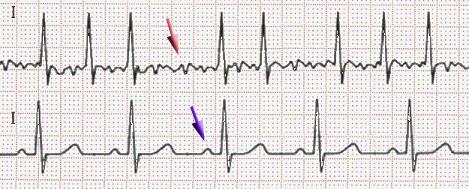Definition: Atrial Fibrillation from Wikipedia, the Free Encyclopedia.
Atrial fibrillation (AF or A-fib) is the most common cardiac arrhythmia (irregular heart beat). It may cause no symptoms, but it is often associated with palpitations, fainting, chest pain, or congestive heart failure. However, in some people atrial fibrillation is caused by otherwise idiopathic or benign conditions.
 |
| ECG of atrial fibrillation (top) and normal sinus rhythm (bottom). The purple arrow indicates a P wave, which is lost in atrial fibrillation. |
In AF, the normal regular electrical impulses generated by the sinoatrial node are overwhelmed by disorganized electrical impulses usually originating in the roots of the pulmonary veins, leading to irregular conduction of impulses to the ventricles which generate the heartbeat. AF may occur in episodes lasting from minutes to days ("paroxysmal"), or be permanent in nature. A number of medical conditions increase the risk of AF, particularly mitral stenosis (narrowing of the mitral valve of the heart).
Atrial fibrillation may be treated with medications to either slow the heart rate to a normal range ("rate control") or revert the heart rhythm back to normal ("rhythm control"). Synchronized electrical cardioversion can be used to convert AF to a normal heart rhythm. Surgical and catheter-based therapies may be used to prevent recurrence of AF in certain individuals. People with AF often take anticoagulants such as warfarin to protect them from stroke, depending on the calculated risk. The prevalence of AF in a population increases with age, with 8% of people over 80 having AF. Chronic AF leads to a small increase in the risk of death. A third of all strokes are caused by AF.
See the full article Atrial fibrillation From Wikipedia, the free encyclopedia.
AF and The Risk of Stroke (by Boehringer Ingelheim)
Strokes happen in atrial fibrillation when pools of blood form in the heart because of the upper chambers of the heart (the atria) not contracting properly.Understanding Atrial Fibrillation (AF)
AF is a condition that causes the heart to beat too quickly and in a disorganized way. As you probably know, the heart’s job is to pump blood around the body. It does so with a regular squeezing action which we call our heartbeat, and normally our heart beats in a steady rhythm.AF interferes with this usual rhythm which means blood cannot be pumped around the body as efficiently.
Atrial fibrillation affects approximately 350,000 people in Canada and is the most common heart rhythm abnormality for adults. This website is designed to give you a better understanding of AF and the importance of following your doctor’s advice.
Know the Symptoms of AF
People experience AF differently. For some there are no symptoms during an AF episode, particularly if their heart rate is not very fast, but those who do have symptoms might experience:- palpitations,
- dizziness,
- chest pains,
- breathlessness, particularly with exertion or anxiety,
- irregular and fast heartbeat.
Why Having AF Increases Your Stroke Risk
If you have atrial fibrillation (AF), your risk of stroke is considered three to five times higher than those without AF. Fortunately – with your physician’s help and by taking some practical steps – you can take action to lower this risk.The irregular heartbeat caused by AF means the blood moves unevenly in the chambers of the heart. Sometimes it can pool and get stuck in the heart, which may result in the formation of a blood clot. A clot formed this way can be transported in the blood stream to the brain where it can cause a stroke.
Please go to StrokeAndAF.ca to get further information about Stroke and Atrial Fibrillation.
Watch the TV ad - Stroke and Atrial Fibrillation
Can we talk about stroke?
It may be an awkward topic, but it’s important to talk about the link between AF and stroke and how people can help reduce their risk. We enlisted a few friends to help have that talk with your mom or dad. In just a few easy steps, create and email a personalized video and be on your way to starting “The Talk” with your loved one. See Build a Video Message on StokeAndAF.ca.Meet Our Friends
Meet Jonathan.
His father died from atrial fibrillation-related stroke and his mother and brother have now been diagnosed.Meet Mary.
Her husband has atrial fibrillation.Meet Adam.
His father has atrial fibrillation.Meet Hannah.
Her husband suffered an AF-related stroke, and she is his caregiver. Hannah also has atrial fibrillation.Meet John and His Wife Donna.
John has been diagnosed with atrial fibrillation.Please go to StrokeAndAF.ca to get further information about Stroke and Atrial Fibrillation.
SSTattler: This article is showed by SSTattler and Copyright by Privacy Policy by StrokeAndAF.ca and the according private communication between SSTattler and Boehringer Ingelheim (Canada) Ltd.
Privacy Policy by StrokeAndAF.ca. ....
Use: All content on this website belongs to StrokeandAF.ca and is protected by copyright. Permission to use documents (such as white papers, press releases, datasheets and FAQs) from this site is granted, provided that (1) this permission notice appears in all copies, (2) use of such documents from this site is for informational, media and non-commercial or personal use only and will not be copied or posted on any network computer or broadcast in commercial media, and (3) no modifications of any documents are made. Any other use of the documents from this site must be expressly permitted by StrokeandAF.ca.


No comments:
Post a Comment